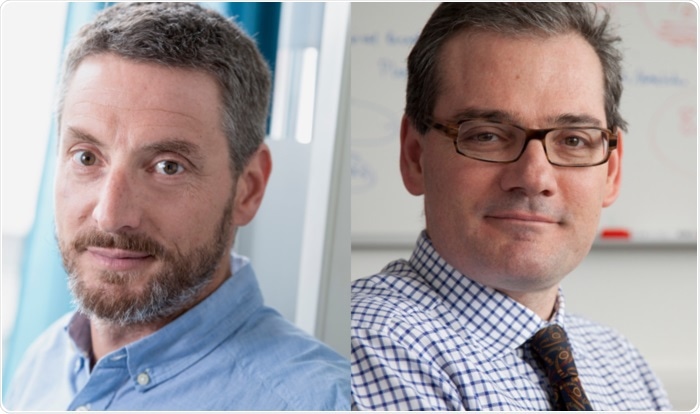Recent research from the Ludwig Cancer Research led to a very effective technique to create many immune cells particularly engineered to identify neoantigens—small fragments of randomly mutated proteins that are specifically exceptional to a patient’s cancer—and annihilate the tumors that express them.

Investigator Alexandre Harari and George Coukos, Director of the Lausanne Branch of the Ludwig Institute for Cancer Research. Image Credit: Ludwig Cancer Research.
The technique devised by a group of Ludwig Lausanne scientists headed by investigator Alexandre Harari and George Coukos, Director of the Lausanne Branch of the Ludwig Institute for Cancer Research, was named NeoScreen. This technique substantially enhances the identification of a patient’s neoantigens and holds considerable promise for the generation of personalized immunotherapies for cancer.
The details of NeoScreen and its use and efficiency in a preclinical study were published in the Nature Biotechnology journal.
We wanted to develop a better way to both identify the neoantigens uniquely expressed by a patient’s tumors and efficiently isolate and expand the immune cells—tumor-infiltrating T cells, or TILs—that are spontaneously directed against them, since it is these rare cells that are considered to be best at destroying cancer cells.”
Alexandre Harari, Investigator, Ludwig Institute for Cancer Research
Harari further adds, “NeoScreen allows us to do all that. Better yet, it permits the identification of the specific receptors these T cells use to recognize neoantigens so that we can equip other T cells from a patient’s blood with that machinery and use those cells as well for personalized immunotherapy.”
To pinpoint neoantigens and grow the T cells that identify them, the scientists ordinarily isolated TILs from a tumor and cultured them with the tumor’s constituent cells in the presence of immune factors that induce T cell proliferation.
As neoantigen-specific TILs are very scarce, the wholesale stimulation of T cell growth mostly results in the greater expansion of T cells that are not particularly targeted to neoantigens. This results in drowning out the most desired neoantigen-targeting T cells in cultures.
To overcome this limitation, Harari, Coukos, and their co-workers initially modified the company where the isolated TILs were cultured. They introduced antigen-presenting cells (APCs) into the mix.
APCs exhibited antigens linked to disease to the T cells and helped trigger the activation and proliferation of those that identify the presented antigen. However, rather than using typical APCs—like dendritic cells—the scientists engineered another kind of immune cell—B cell—to be a highly effective antigen-presenting cell.
B cells were believed to be best suited for this role as they are highly abundant in the blood and more docile to genetic manipulation than dendritic cells.
The scientists later employed computational methods to examine the genome of tumor cells and pinpoint randomly mutated parts of proteins that can be presented as neoantigens. They then pulsed the engineered B cells with the protein fragments—or inserted DNA coding the fragments into the B cells—to get them to present the antigens. Eventually, the researchers cultured the B cells with tumor cells and the TILs isolated from that tumor.
As antigen recognition stimulates T cell proliferation, this co-culture had the effects of selectively and dramatically widening the TILs that identify neoantigens expressed by the tumor.
The scientists isolated the TILs, determined the neoantigens they identified, and sequenced the genes encoding their neoantigen-detecting T cell receptors (TCRs). This approach led to the recognition of more varieties of both expressed neoantigens and TCRs compared to traditional techniques.
The scientists demonstrated that neoantigen-specific TCRs can be cloned and introduced into other T cells collected from blood to create huge amounts of tumor-targeting T cells.
NeoScreen enabled the selective expansion of neoantigen-targeting TILs against melanoma as well as colon, lung, and ovarian cancers.”
George Coukos, Director, Lausanne Branch, Ludwig Institute for Cancer Research
The scientists finally analyzed if the NeoScreen could be beneficial for adoptive T cell therapy, where T cells collected from a patient are isolated, selectively expanded, and reinfused into a patient.
The researchers demonstrated that T cells engineered to express TCRs pinpointed with NeoScreen identified neoantigens seen in tumors and can trigger the regression of those same tumors after they were firmly established in a mouse model.
NeoScreen could also be used to identify neoantigens for the design of personalized cancer vaccines for therapy. We will be testing this and other applications of NeoScreen for cancer immunotherapy at Ludwig Lausanne.”
George Coukos, Director, Lausanne Branch, Ludwig Institute for Cancer Research